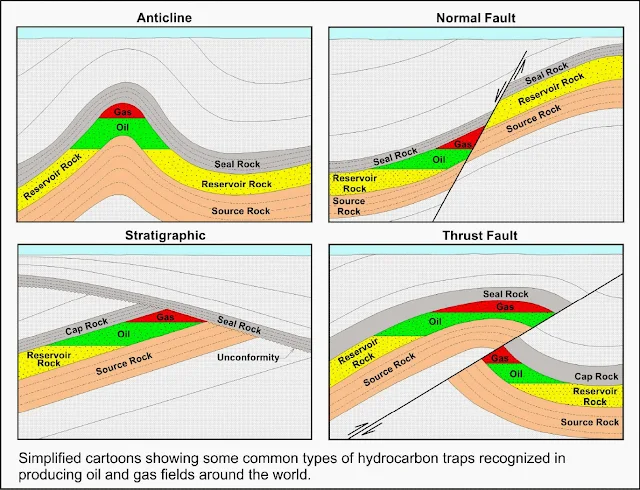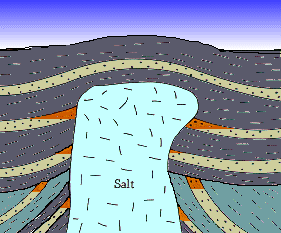Hydrocarbon Traps
 |
| Hydrocarbon Traps |
Hydrocarbon traps are geological formations that trap oil and natural gas underground, preventing them from migrating freely through rock layers. These traps are essential for the accumulation of commercially viable hydrocarbon reserves.
Hydrocarbon traps form where permeable reservoir rocks (carbonates, sandstones) are covered by rocks with low permeability (caprocks) that are capable of preventing the hydrocarbons from further upward migration. Typical caprocks are compacted shales, evaporites, and tightly cemented sandstones and carbonate rocks.
The caprock need not be 100% impermeable to water, oil or gas. If the upward loss of hydrocarbons is less than the supply of hydrocarbons from the source rocks to the trap, hydrocarbons may still accumulate.
Basic Trap-Fluid Nomenclature
Traps are usually classified according to the mechanism that produces the hydrocarbon accumulation. The two main groups of traps are those that are formed by structural deformation of rocks (structural traps), and those that are related to depositional or diagenetic features in the sedimentary sequence (stratigraphic traps).
Many traps result from both of these factors (strati-structural or combination traps). A common example is stratigraphic pinch-out (e.g., a sandstone lens wedging into mudstone) that is combined with tectonic tilting (which allows hydrocarbons to pond in the updip part of the sandstone wedge). Other traps result mainly from fracturing (which creates the reservoir porosity) or hydrodynamic processes.
There are many classifications of hydrocarbon traps in use, but most have ~90% in common…
Anticlinal (Fold) and Dome Traps
a) Simple fold traps (anticlinal) with axial culmination (fold axis dipping in two or more directions). The simplest type of trap is formed when a sandstone bed that is overlain by tight (i.e. low permeability) shale is folded into an anticline. A simple anticline, however, may not necessarily be a trap. The crest of the anticline must have an apical culmination (i.e. a peak) somewhere along the fold axis so that hydrocarbons can be trapped. Anticlinal traps are commonly detected by seismic reflection. In mature oilfields, most of these simple traps have probably been found, but many anticlinal traps remain to be discovered offshore and in new prospective areas.
b) Salt domes: Strata around the salt dome curve upward creating traps against the sealing salt layers (see below for more details).
c) Growth domes. Domes or anticlines that form during sedimentation when one area subsides more slowly than the surrounding areas. Their formation is concurrent with sedimentation (i.e. they form during deposition), and not due to later (tectonic) folding.
Growth anticlines may form due to differential compaction over salt domes or other upward-projecting features in the substrate (topographic highs on the buried landscape).
Fault Traps
The fault plane must have a sealing effect so that it functions as a fluid migration barrier for reservoir rocks.
There are several common types of fault trap:
a) Normal faults — commonly associated with graben (rift) structures.
b) Strike-slip faults — these may not be sealed due to incremental movements, but basement-controlled strike-slip faults commonly produce good anticlinal structures in overlying softer sediments.
c) Thrust faults — commonly associated with compressional tectonics (e.g., the Front Ranges in Alberta).
d) Growth faults — Growth faults typically form in sediments that are deposited rapidly, especially at deltas. Faulting occurs during sedimentation (i.e. syndepositionally), such that the equivalent strata on the downthrow side will be thicker than on the upthrow side.
The throw between corresponding strata declines upwards along the fault plane. Minor fault planes with an opposite throw (antithetic faults) may also form in the strata that curve inward towards the main fault plane. The fault plane is commonly sealed, preventing further upward migration of oil and gas.
Fault traps may also form when sandstone beds are offset against the fault plane. Some petroleum traps, however, form in "roll-over" anticlines on the down-faulted block. Growth faults may reduce porewater circulation in sedimentary basins; consequently, undercompacted clays, which may develop into clay diapirs, are often associated with growth faults.
Some general points about fault traps…The geometry and timing determine whether faults will be effective in forming fault traps:
- Dead faults that predate basinal sediments only affect the underlying basement – they play no direct role in hydrocarbon trapping in the younger sedimentary pile.
- Continuously developing faults (growth faults) — these are active during sedimentatioand are major petroleum traps (e.g., Niger Delta).
- Young (late) faults —these form late during sedimentation; depending on their initiation and growth, they may or may not be effective as traps.
- Late regenerated faults —these are new movements on old faults — they are more likely to destroy than form traps, but may be effective.
Many petroleum fields are closely linked to faulting, but traps that result from faulting alone are less common. There are three common fault – petroleum pool associations:
- The fault itself makes the trap without an ancillary trapping mechanism such as a fold —normal faults are the most common examples.
- The fault creates another structure (e.g., a fold or horst) that in turn forms the main trap.
- The fault may be a consequence of another structure that forms the main trap — e.g., the extensional crestal faults that form above some anticlines.
Important point: Faults are highly ambiguous features. They may leak, acting as permeable conduits for fluid flow (including oil and gas migration), but more commonly act as seals unless they are rejuvenated after petroleum has pooled.
Salt Dome Reservoirs
Salt domes form when salt is less dense than the overlying rock, and the salt moves slowly upwards due to its buoyancy. For this to happen, there must be a minimum overburden and the thickness of the salt deposits must be more than ~100 m. Upward movement of salt through the sedimentary strata, and associated deformation is termed halokinetics or salt tectonics. Movements may continue for several hundred million years.
Traps may form (1) in the strata overlying the salt dome, (2) in the top of the salt domes (the cap rock - caused by brecciation and dissolution), (3) in the strata that curve upward against the salt intrusion (4) due to stratigraphic pinch-out of strata around the salt dome:
Salt dome reservoirs produce major oilfields where basinal sediments contain thick salt deposits. Salt deposits are common in Permian-Jurassic sediments around the Atlantic Ocean. Examples include the Gulf of Mexico, where there is Permian and Jurassic salt, the Permian Zechstein salt in NW Europe and the North Sea.
Stratigraphic Traps
Stratigraphic traps are created by any variation in the stratigraphy that is independent of structural deformation, although many stratigraphic traps involve a tectonic component such as tilting of strata.
Two main groups can be recognized
Primary stratigraphic traps result from variations in facies that developed during sedimentation. These include features such as lenses, pinch-outs, and appropriate facies changes.
Examples include:
- Primary pinch out of strata, e.g., strata that pinch out updip in less permeable rocks such as shale;
- Fluvial channels of sandstone that are isolated and surrounded by impermeable clay-rich sediments;
- Submarine channels and sandstone turbidites in strata rich in shale;
- Porous reefs that are surrounded by shale, etc.
Secondary stratigraphic traps result from variations that developed after sedimentation, mainly because of diagenesis. These include variations due to porosity enhancement by dissolution or loss by cementation.
Paleogeomorphic traps are controlled by buried landscape. Some are associated with prominences (hills); others with depressions (valleys). Many are also partly controlled by unconformities so are also termed unconformity traps.
Hydrodynamic Traps
If porewater flow in a sedimentary basin is strong enough, the oil-water contact may deviate from the horizontal because of the hydrodynamic shear stress that is set up. In some cases, oil may accumulate without closure. Flow of fresh (meteoric) water down through oil-bearing rocks commonly results in biodegradation of the oil and formation of asphalt, which may then form a cap rock for oil.
By understanding the different types of hydrocarbon traps and the geological processes that form them, we can improve our ability to explore for and develop valuable oil and natural gas resources.









%20(1).webp)




.jpg)
